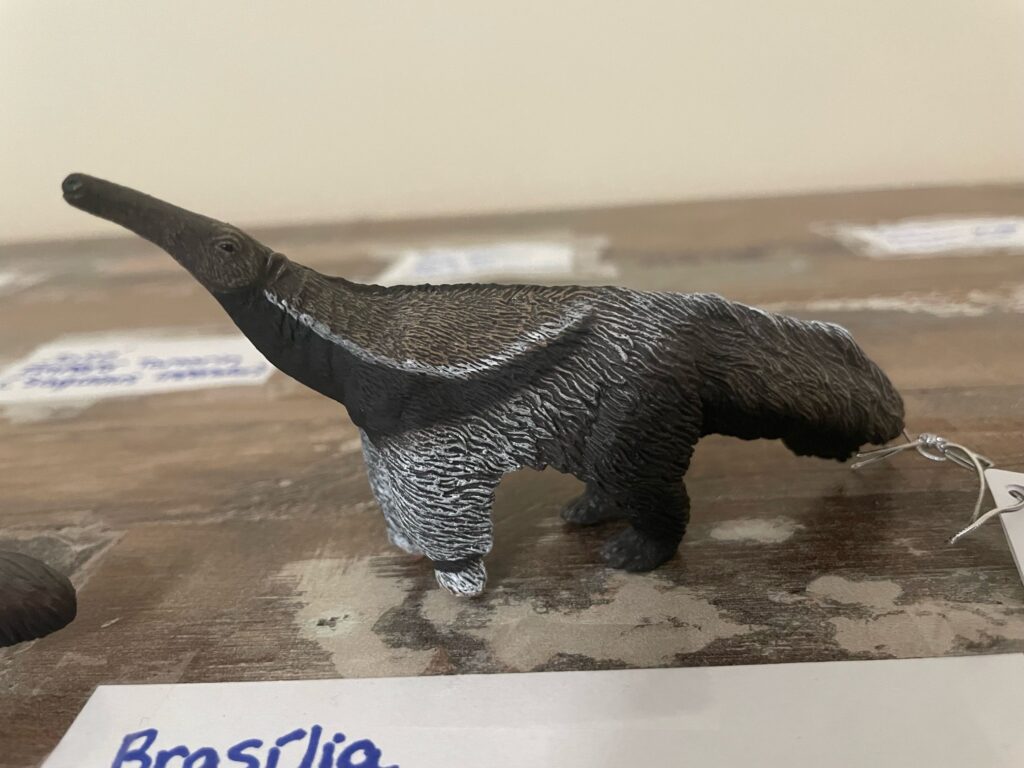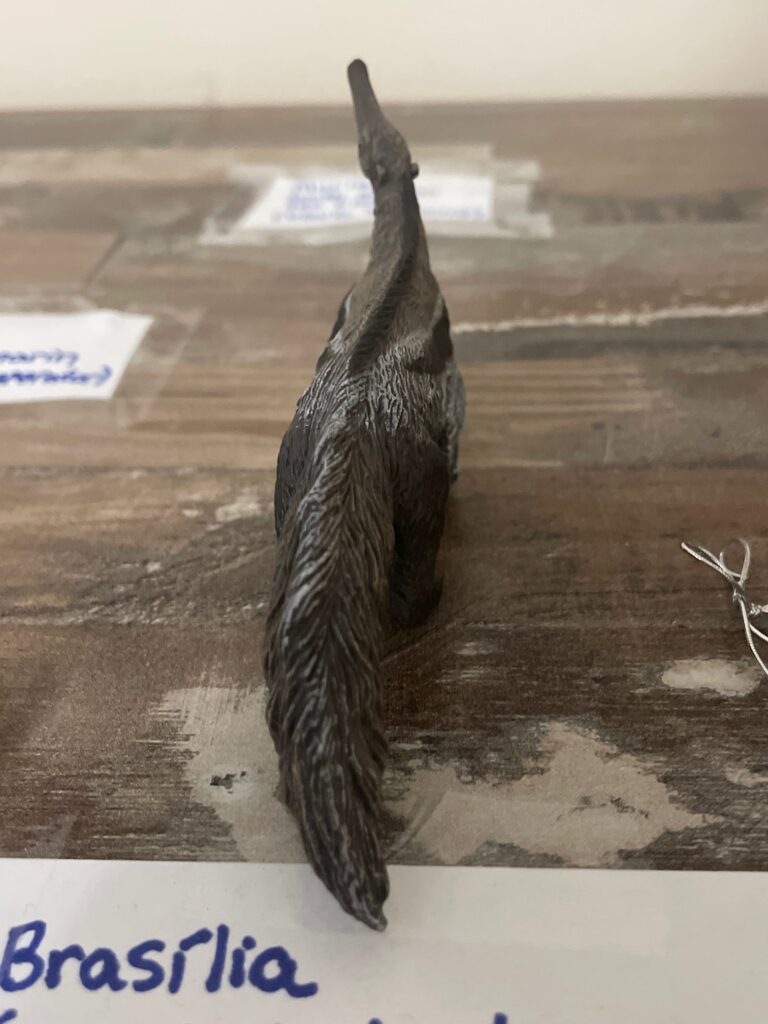Review and images by Sam; edited by bmathison1972
Growing up, the amazing wildlife of South America have always fascinated me, amazed by their beauty and uniqueness as well as their ecological niches. Recently, to nurture this fascination, I have started a miniature figure collection of South American animals, with a heavy emphasis on Brazil, the world’s most biodiverse country. Within its amazing habitats including the Pantanal, Cerrado, and of course the Amazon Rainforest, you can find some of the most unique fauna on the planet, including the giant anteater (Myrmecophaga tridactyla), the subject of today’s review.

An animal of absurd proportions, the giant anteater is the largest of the anteater species as well as the largest living member of Xenarthra, a group of placental mammals characterized by fused pelvic bones, spine reinforcing bones, and a peculiar blood vessel structure that allows energy sparing by an extremely low metabolic rate. They are classified within the clade Pilosa along with the sloths. With a long snout, lack of teeth, a two-inch-long sticky tongue, and sharp, four-inch claws, these animals were built for the sole purpose of tracking down and slurping up ants and termites. The giant anteater can be found in the tropical rainforests, grasslands, and swamps of Central and South America, where they play an important ecological role in their native ecosystems to control the populations of ants and termites. Unfortunately, they are listed as “Vulnerable” on the IUCN Red List, and some of the threats this species faces includes habitat destruction for development and agriculture, roadkill, hunting, and climate change, and sadly, they are already extinct in the countries of Uruguay, Guatemala, and El Salvador, as well as some parts of Peru and Brazil, a stark reminder of the irreversible damage we humans could cause if we do not become more environmentally conscious.

When I started my miniature Brazilian animal collection, I knew I had to buy CollectA’s newly-released giant anteater to represent this species in my menagerie. Since she has not hit shelves here in the US just yet, I had her imported all the way from Australia, purchased from a website called MiniZoo. She came in just yesterday, and I am not disappointed.

This model is probably the most accurate giant anteater model in the toy animal market. Of course, she is manufactured by CollectA, a company well-known for its rather scientific animal reproductions, so this is to be expected. I’m so glad they finally produced a figure that is incredibly faithful to my favorite animal of all time. Now let’s see what makes her stand out.

Let’s start off with the paintjob. This model’s paintjob is extremely accurate and true-to-life. While most companies would just lazily slap on that distinctive black-and-white stripe as a V-shaped marking on most giant anteater figures I have seen, making them look a bit more cartoonish, her stripe runs the entire length of both sides of her body, conforming to the curves of her body to cause the white line to form a graceful curve along each side of her body. Additionally, her colors are very naturalistic, with natural transitions between each color as well as an overall more greyish-brown color than the flat grey, black, and white you’d see on most giant anteater figures.
Her front legs are also painted accurately compared to other figures of the species. Most manufacturers leave the front legs of their giant anteater figures grey, white with a very faint hint of the distinctive black stripe just above the front feet, or just plaint white with no black stripe, but CollectA went above and beyond to paint her legs as true to the real animal as possible. This is the second giant anteater figure to do this, after Papo’s figure released in 2013 (and released in 2023), although the paint job on this model is more accurate. It is clearly reminding me of the viral post from a few years ago comparing the front leg of a giant anteater to the face of a panda.
But the amazing paintjob does not end there. The bottom of her feet are painted a reddish-pink, further adding to the accurate paint job, as I have seen in photos of real giant anteaters a very faint hint of that color on the bottom of their feet.

Now onto anatomy. This giant anteater wins over the other giant anteater figures as the most anatomically accurate. Her body is sculpted with accurate proportions, and her snout is just the right size, something other manufacturers just can’t get right (for example, Mojö Fun’s giant anteater from 2023, which I also own and did a review on this website just last month, has a snout that is a bit too short). She also has a very cute face, including nice attention-to-detail with her nostrils and mouth, as well as her nose is tipped with shiny black paint to mimic the wet black nose of a real giant anteater.

Her front feet are accurately sculpted as turned inwards, since giant anteaters walk on their knuckles to keep their claws sharp. Her back feet also have claws sculpted into them. She has wrinkles on the side of her neck to indicate that her head is turned, as well as prominent shoulder bone definition above her front legs. Her tail is not just one large hunk of plastic like on most giant anteater figures; rather, it is very flowy-looking and detailed, almost reminiscent of Spanish moss. She has a mane running along her spine, painted in black to help it stand out against her body. And finally, her fur texture is very detailed, giving her a shaggy look.
Finally, this model boasts a very unique pose. Most giant anteater figures are sculpted as if they are walking along and sniffing for ants and termites, but this one has her in a static pose with her head titled up and her long snout pointing towards the sky, giving her a very “showy” pose, which further adds to her beauty and unique charm.
At just 4 inches long and 2 inches tall, this giant anteater model is the perfect size for any South American animal collection or diorama. She looks absolutely stunning in my Brazilian wildlife collection, fitting in seamlessly with my other specimens, and I bet she will fit it perfectly with yours. Due to the more scientific nature of CollectA’s figures, she is more geared towards collectors than as a child’s toy, especially for display purposes.

Overall, with no inaccuracies to be found and a beautiful appearance, I highly recommend this giant anteater figure to all collectors. Since it is still early in her release, she may be a bit hard to find her online, but, in my unbiased opinion, I still think she is the best giant anteater figure on the market and every collector should own her. In fact, she was my dream animal figure thanks to her accuracies in both anatomy and color, and I have always wanted her ever since CollectA announced her as part of their 2024 lineup late last year. Amazing job, CollectA. You never fail to disappoint with your figures.
Disclaimer: links to Ebay and Amazon on the AnimalToyBlog are affiliate links, so we make a small commission if you use them. Thanks for supporting us!




I like how this one is posed. Great review!
Thank you so much! I love her unique pose as well.